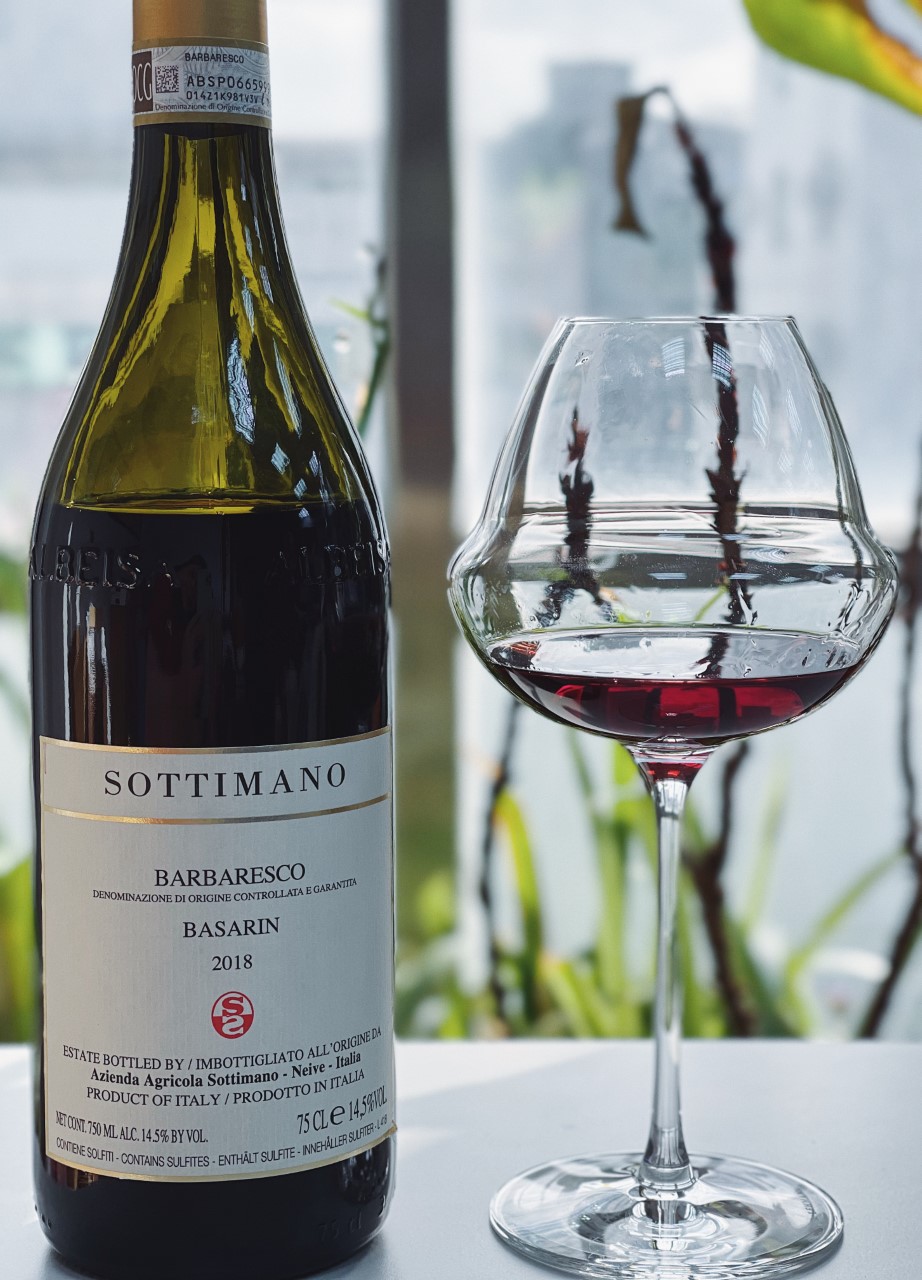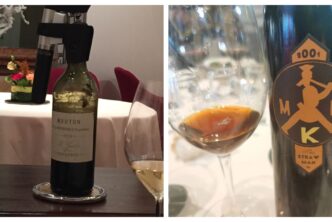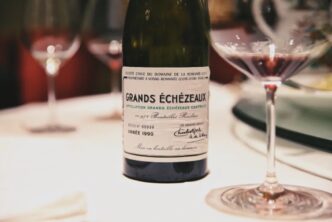Sottimano 2018 Barbaresco Basarin 94

Sottimano first made a Barbaresco from the Basarin cru in 2015. He bought his holdings in this prestigious area in 2001, 2013, 2015 and most recently 2018, when he added . outh-west facing at the border of Neive and Treiso (but belonging to the commune of Neive), the Basarin cru is situated at a relatively high altitude and its wines are consequently usually more lifted and lighter on their feet but also less tactile and rich than those of, for example, Rabaja’ in Barbaresco or Serraboella in Neive. Andrea Sottimano’s version is made from 25-65 years old vines planted in a three hectare plot, and the wine he makes with these grapes is usually one of the most approachable, when young, among the many crus in his stable of Barbarescos. At the same time, it is usually more complex and concentrated than the Basarin wines of many of his colleagues.
Bright red, the Sottimano 2018 Barbaresco Basarin offers a complex but forward, open-knit nose of sweet spices, red cherry, dried rose petal and licorice. The licorice and even a hint of minty spices repeat on entry and in the middle with the licorice component dominating (as it often does in wines from Basarin) on the long seamless finish. Maybe not the most concentrated wine Andrea Sottimano has ever produced, this is nonetheless a lovely wine that will deliver lots of pleasure with more than a decade plus of very fine drinking ahead. The wine reflects Amdrea Sottimano’s hands-off approach to winemaking, with less intervention in the cellar than was common at the winery say fifteen years ago, with an almost Burgundian feel to the winemaking. Traditionally macerated long on the skins and fermented with natural yeasts only, the wine remains on the lees for the entirety of its 24 months spent in French oak barriques (10% new) and is bottled unfined and unfiltered. Drinking window: 2027-2034.
Dönnhoff 2006 Oberhäuser Brücke Riesling Beerenauslese 93

When it comes to estate’s like Dönnhoff, wine writing becomes (almost) easy. That’s because Dönnhoff is one of Germany’s ten best wine estates, and their wines are true monuments to Riesling. The family has been farming the Oberhäusen vineyards ever since they arrived in the area roughly 250 years ago, though at first like most every other family in the area also dabbled in growing other vegetables and even raising livestock. The wine estate was officially founded in the 1920s by Hermann Dönnhoff (also the first name of the second Dönnhoff to run the show, followed by Helmut and then Cornelius, the fourth generation at work who joined forces with his father in 2007) but it is only fair to recognize that it was Helmut who first put it on the world quality wine map. The roughly twenty-five hectares of top sites in the Nahe region of Germany are farmed carefully, with grass and compost littered between rows to help preserve water (at Dönnhoff no irrigation is used) and prevent erosion. Vines are trained low to the ground to help catch heat from the stones in the soil and ensure optimal maturity. The Brücke is a real grand cru and the site from where I personally think Dönnhoff makes his best wines, as its slate, porphir, loam, and sandstone makeup help deliver complex, rich, concentrated wines I never tire of. The latest bottle of Dönnhoff’s 2006 Oberhäuser Brücke Riesling Beerenauslese strikes me as being one of the heavier, richer wines I have ever tasted from Dönnhoff at this sweetness level. Downright viscous and oily, it is most definitely less vibrant at the same stage of development than the Auslese of same vintage and vineyard, though clearly it is a great deal sweeter, deeper, more complex and creamier. I have had this 2006 BA on numerous occasions and last tried it in the summer of 2018; my notes show that I did not find it quite as sweet then as I find it to be today, though the wine was obviously just as wonderful then as it is now. My most recent tasting of this little beauty just a few days ago shows a bright golden yellow colour. The nose offers a panoply of tropical fruits (mango, papaya, pineapple), fresh orange and tangerine, even raspberries, not to mention plenty of honey and very gentle sweet spices, complicated by hints of smoky botrytis. Flavours similar to the aromas greet the palate, where there is very good mid-palate depth but a little less grip than I would have liked on the long, very pure finish. This specific bottle didn’t quite strike me as being as fresh as I remembered it being on other occasions, but I am happy to say I still have three more bottles of this little gem in my cellar, and so I look forward to enjoying it quite some more in the years to come. I may be wrong, but I think I’ll be scoring all three higher than I did this bottle. Or maybe, because it’s the great Dönnhoff we are talking about here, I’m just too hard to please. Drinking window: now-2035.

 English
English


Not to be too heretical, I almost always prefer a first rate Auslese to a Beerenauslese. The sugar and botrytis are dominant at the BA level. A successful Auslese walks the line between rich and too rich. The acidity of an Auslese is usually quite evident and acts to balance the sugar and the noble rot.
You are not being heretical at all, I think many German wine lovers probably agree with you. I think it’s always a matter of balance: a good Auslese is always better than a bad BA, but then again, a good BA is also always better than a bad TBA, and so forth. I think the one caveat might be noble rot: for those like me who absolutely love the stuff and would actively squeeze it in almost everything he drinks, orange juice included, a well-balanced, harmoniously acidic BA with tons of the good old fungus in every droplet will always be the equivalent of heaven on Earth, and greatly prefer them to the many Auslesens, even very great ones, but that not made with oodles of nobly rotten grapes. For the same reason, as much as I love the 1983 Mosel wines I find them a little too linear in their essentially Botrytis -free charm and so much prefer a wine from 1976 (granted, one with enough acidity) or 1989. But again, I think there’s no right answer here. Salute!
The changes Andrea has made in the vineyard and winery approach have made the wines a pure delight to drink. I enjoyed hearing him speak candidly about the change in approach and why it was necessary. I have yet to try this ‘cru’ but if the wines deliver like the Curra, Cotta, Fausoni or Pajore, consider me an instant fan of this high altitude wine! Cheers!
Ciao Steve,
I personally love the Curra’ and especially Pajore’, but I guess it’s a case of different strokes for different folks, mostly. Maybe both those vineyards really are superior to the Basarin, but the latter is an extremely famous site that has many fans, and that deserves its place in the sun, as many great wines are made from it. This is why I chose to write about it as opposed to a wine from one of Sottimano’s other long time and hence better known crus. I think you can’t help but become a big fan of the Basarin, as all of Sottimano’s wines, given that the estate is easily one of the five or six best producers of Barbaresco (I’ll be deliberately vague with that assessment or Andrea might get a fat head….just kidding!). So I totally get your point! Cheers!
Grazie Ian! Found a few of the 2016 Basarin to purchase and taste. Definitely looking forward to it….and yes, no need to stroke Andrea’s ego more. Haha! All the best! Steve
Great, let us know what you think, I’m interested. Plus I really love the classic mouthfeel of the 2016 vintage, though clearly these are wines that need a little time in the cellar!